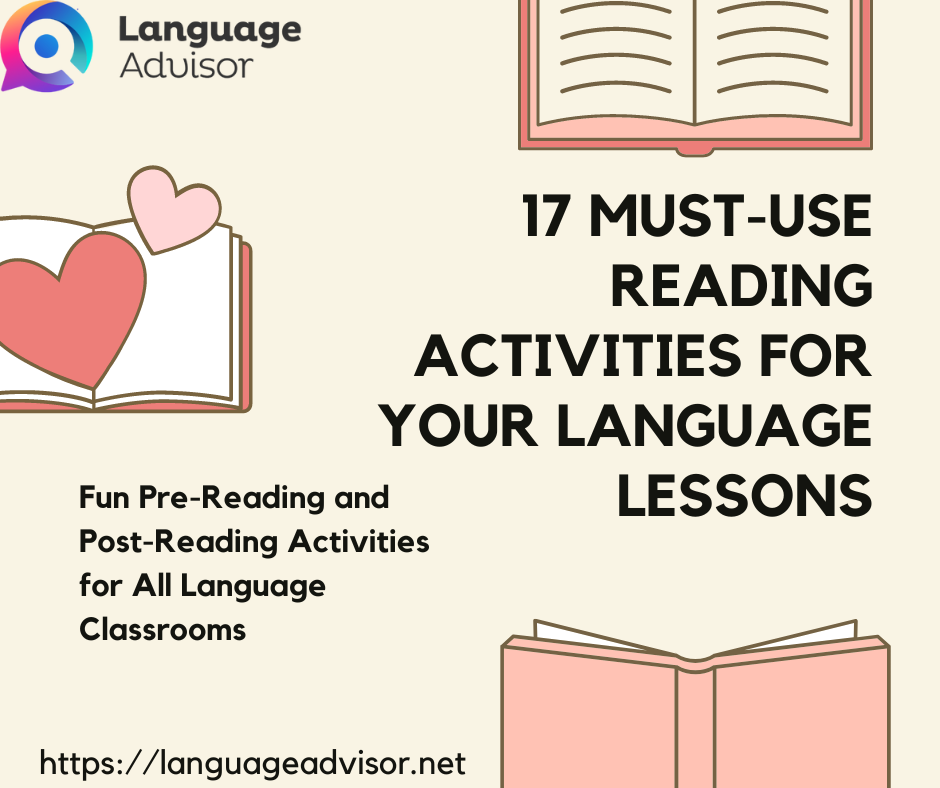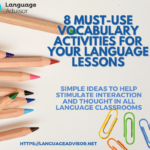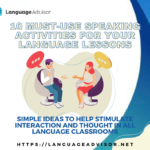17 Must-Use Reading Activities For Your Language Lessons. Fun Pre-Reading and Post-Reading Activities for All Language Classrooms
17 Must-Use Reading Activities For Your Language Lessons
17 Must-Use Reading Activities For Your Language Lessons. Fun Pre-Reading and Post-Reading Activities for All Language Classrooms
17 Must-Use Reading Activities For Your Language Lessons
A list of 17 Must-Use Reading Activities For Your Language Lessons to engage your students.
Reading activities, for a communicative teacher, often involve helping learners know how to read using a number of different strategies. While many of your learners may think that reading simply involves going word by word and sentence by sentence, researchers now understand that reading is an involved process that can be aided by a number of different techniques and activities.
Your job as a teacher is to help learners recognize that reading is an elaborate process that might involve predicting, scanning, skimming, and asking questions (to yourself and to others). Having a specific focus can also help to improve reading skills, such as an attempt to focus on general meaning, specific facts, a particular grammatical item, guessing a word in context, and so forth.
Please recognize that a teacher plays a significant role in helping learners “unpack” written language through the use of multiple reading strategies.
Nine-tenths of education is encouragement.
~
Anatole France

17 Must-Use Reading Activities For Your Language Lessons
What follows are a few very simple ideas to help stimulate interaction and thought in an classroom.

Predict from a Title
Description
Students are invited to read a title of the reading and then predict what it could be about.
Give students time to discuss different possibilities, and help them elaborate on those possibilities.


Story Guesswork
Description
Students are asked to guess what a story will be about after skimming the first paragraph, looking a series of pictures, or reading a short description of the characters. Guessing a storyline can intrigue students and get them thinking about key vocabulary. Writing key vocabulary on the board can also help their ability to predict and get them thinking about the reading ahead of time.


Boardwork Scanning
Description
In this reading exercise, write a definition of a word on the board without the word itself. Invite students to look for the word in the reading that has this particular meaning. This can be done as students are reading, thereby keeping them alert while reading. For more advanced students, you might invite them to look for a sentence or sentences that answer questions you have placed on the board. Board work like this can help students increase their scanning skills and can help students “look” for all kinds of important details. Using these techniques, you can ask students to search for an interesting sentence, a main idea, a sentence that reminds them of a story, a sentence that the student disagrees with, and so forth.


Reading with Half the Words
Description
Since many readings offer a number of words students don’t know, this exercise can help students realize that they don’t need to know every word in order to understand general meaning. This activity also helps students understand the importance of guessing in context.
This reading activity is done by removing half of the words of a text, which can be done easily by cutting a story or article in half vertically, or asking students to cover half of the words with another piece of paper. Now with only half of the words visible, students must try to guess or anticipate what the reading is talking about. Often, a series of questions can be asked about the article to help students guess the meaning. After learners have read the article, the rest of the article is revealed and students investigate how well they were able to predict. If done correctly, this can demonstrate to students how well they can answer questions without knowing every word in a reading.


Reader’s Outline
Description
Invite students to create an outline of an article or story they have just read. An outline can help students recognize main and subordinate ideas. It also helps to increase memory and gives teachers a chance to assess student ability to identify supporting details. This activity is greatly enhanced when asking one or more students to share their outlines on the board, and then discuss with a class which details might be added.
Here is an example


Character Map
Description
A character map allows students to explore a particular character in a story.
Either select a character or have students choose a character from a story. Then have them draw a picture of the character and add symbols and details to describe the character’s personality, struggles or problems, and physical characteristics. This can be a predictive activity as well, and you can ask students what you hope will happen to the character and/or what they think will happen to the character later on.
Here is an example of a map

Here is a PDF Worksheet


Reading Log
Description
A reading log allows students to show what they are reading outside class. There should be a set time each week when students are able to share with each other what they read. They can write down answers to questions, discuss what they liked about what they read, ask questions to others who have read the same book, or whatever you as a teacher would like to have them do in the reading log. A reading log simply means that you invite students to engage in what they are reading. You can use a reading log to help students use the vocabulary they learned in the reading, writing sentences using the words they did not know previous to the reading, or writing a story based on a minor character, or writing as if they were one of the characters.
Here is an example


Scrambled Sentences
Description
Several sentences from the reading (for example, 5-6 for beginners, and as many as 10 sentences for advanced learners) are cut into equal-sized strips of paper.
Students are required to put them in the correct order either in pairs or groups.
For convenience, numbering each sentence (in random order) can help when discussing the correct order.


Picture Books
Description
Picture books are a great way to have students relate stories they are reading to each other. Each student is assigned a book or short story to read. Then the student is invited to create a series of pictures (no more than 10) about the story.
The pictures are used to give the students a chance to summarize the story to a partner or to the class. If necessary, students may write small sentences on the back of each picture. This allows for students to read and then present on whatwas read.


Focus on Organization
Description
Have students look at the organization of a story. Discuss with them what is contained in the first scene, second scene, third scene, and so on. Then have students retell the story by using words such as first, second, and third.


Skits on Reading
Description
After reading an article or story, have students write a short skit based on that story. Students often love to act out the things they have read.


Focus on a Literary Technique
Description
Language teachers can learn a lot from literature teachers. They often help teach students about metaphor, simile, symbols, rhymes, color imagery, description, setting, plot, allusion, or other literary devices. Don’t be afraid to teach good literary techniques as well as language. It may help students to learn to appreciate the beauty of another language, and will certainly help them to engage in reading.


Mapping
Description
Doing a “Mapp” is especially useful when you are inviting students to look at persuasive writing (such as advertisements).
To create a “MAPP”, first have students fold a piece of paper into four sections. Second, ask them to put into each of the four corners one of the following words or phrases (usually clockwise starting from the top left): M: Main Idea, A: Audience, P: Purpose, and P: Personal reaction.
Finally, tell the students to answer, in the space provided, each of the following questions.
M: Main Idea: What is the reading trying to teach?
A: Audience: Who is this reading written for?
P: Purpose: Why did the author write this?
P: Personal Reaction: Why do you like or dislike this reading?
Here is an example

Summarizing/Paraphrase

Description
A summary requires students to take an article or story and relate the main ideas in chronological order. While summarizing is a common activity in some countries, it is not a common practice in others. Thus, teaching learners to condense or summarize information can be an important educational activity.
Asking students to find their own words to summarize can be equally challenging, but can help students to learn how to simplify grammatical structures, create transitional words or phrases on their own, and use synonyms for key vocabulary.


Picture the Story
Description
In this activity, you can invite students to focus on the location of a story by having them draw what they imagine the neighborhood in which the story takes place. It is often helpful to tell them to think of this story as a “movie”: how would it get filmed? What would it look like? This is a particularly good activity for visual learners and those with creative talents.


Rank Order Exercise
Description
Have students read and take notes about ideas that seem important (you could ask, “What are the most important ideas/themes from this reading?”). This could be, for example, the main themes of the reading, the morals of the reading, or just a list of the details themselves. It is best if students write full sentences for each item they list (instead of saying, “child poverty” for example, tell students to write, “Children often live in poverty in Brazilian favelas”).
Then, after students have created a list of ideas (either on the board or on a piece of paper), give students a “ranking form” and invite students to rank, in order of importance, these ideas. Afterwards, you might invite students to share why they ordered the ideas with a partner, a group or the class.
Here is a Rank Order Exercise


Alphabet Reading
Description
While students are reading, write each letter of the alphabet on the board, with space after each letter to write a small response. Then invite students to recall as many facts as they can that start with each letter (For example, “Apricots were John’s favorite fruit. Betty didn’t like John.”) As a variation, provide a sheet of paper with each letter of the alphabet. Individually or in groups, tell students to complete the worksheet. The student or group with the most responses wins.

17 Must-Use Reading Activities For Your Language Lessons
Here are some other reading activities you can find on Language Advisor
Reading Activities For Your Language Lessons












